The king cheetah is one of the rarest animals in the world. Less than 10 are believed to exist in the wild, with a further 50 in captivity.
So, what is a king cheetah?
With its unusual markings, the king cheetah was once considered a different species. However, it is actually the exact same as the African cheetah, other than a mutated fur pattern.
Here is a list of the most fascinating king cheetah facts, detailing everything you need to know about this stunning, elusive cat.
Top 10 King Cheetah Facts (& Beyond)

1. The king cheetah is not a distinct species
These unusual cats have also been known as Cooper’s cheetah.
Major A. Cooper shot a king cheetah in 1926 and noted how the fur was thicker and darker than a normal cheetah. So he named it after himself. Imagine how it used to be! You kill a rare animal and then you get to name it!
In 1927, an English zoologist gave the animal a new name – Acinonyx rex. This is different to Acinonyx jubatus, the Latin name given to a cheetah. Rex translates as king in Latin, which is how their name evolved.
More on this later (cf. fact 19).
2. A rare cheetah with a unique mutated fur pattern
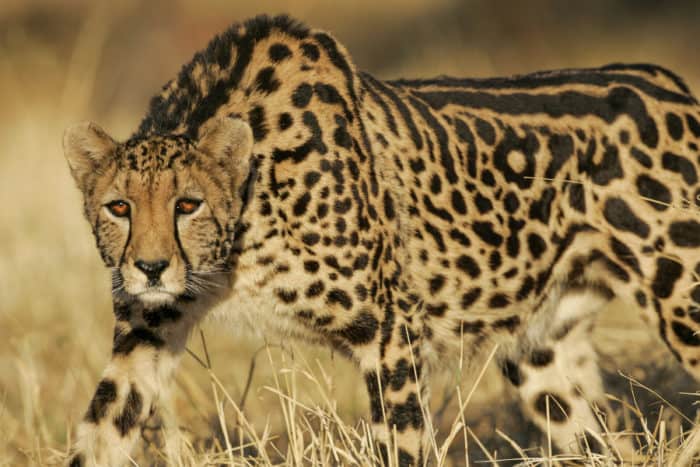
Black panthers can either be jaguars or leopards. They gain their black fur through natural and hereditary melanin or pigment.
It’s similar for the king cheetah. They have a mutated fur pattern caused by a recessive gene.
This means that their distinctive appearance is due to a lack of genetic diversity.
3. They have thicker fur
If you see a king cheetah, it’s obvious that the fur patterns are different.
Look more closely and you will notice how the fur is also much thicker, more like that of a snow leopard.
Cheetahs usually have hoarse, thin hair for surviving in hot arid environments. So this mutation is unlikely to have helped the king cheetah.
4. King cheetah vs cheetah: thick blotchy patterns instead of spots
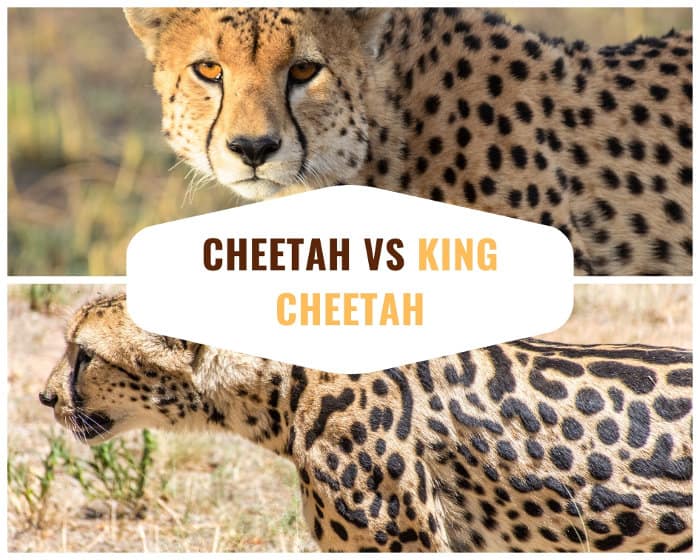
African cheetahs have clearly defined spots. Note that these are different from other cats. Leopards have a rosette pattern while jaguars have larger rosettes with a black spot at their center.
Dark patterns and stripes create a blotchy appearance on the king cheetah. In particular, look at the thick dark bands around the tail and mane.
King cheetahs also have some smaller spots, typically on their legs and face. However, their appearance is markedly different from African cheetahs.
5. The varying coat pattern is due to a recessive gene
As the gene is recessive, it is tough for king cheetahs to reproduce more of their own.
Both parents must have the recessive gene for their offspring to carry it forward. So it takes two king cheetahs to make a king cheetah cub (with 100% success).
If they mate with a normal African cheetah then the distinctive gene is highly unlikely to appear in the fur.
Of course, they can mate with African cheetahs because they are the same species.
6. You probably haven’t seen a king cheetah

Sources claim that there has only been a total of six sightings of the elusive king cheetah in the wild. Six times in the entirety of Africa over the last 100 years!
These sightings happened in Botswana, Zimbabwe, and northern South Africa. The last confirmed wild sighting was in Kruger National Park back in 1986.
Look back 400 years and there’s a good chance that a lot of these cats prowled the African plains. However, such an incredible fur coat will have been a prime target for any hunter.
Global cheetah numbers have declined immensely over the last 100 years. African cheetahs have lost 91% of their historic range and less than 7000 remain. So, it shouldn’t be a surprise that the rare kings are scarcely seen.
7. You can encounter king cheetahs in Africa
These animals do exist, and you can see them in South Africa.
The De Wildt Cheetah and Wildlife Centre was the first to breed king cheetah in captivity. You can now see these mutated cheetahs at the wildlife center, on one of their organized tours.
Note that these are captive cheetahs and can be hand-fed, so many safari lovers will not enjoy the experience.
While the center must receive some credit for helping wildlife preservation, it is not a safari destination and many disagree with the human-animal interaction.
Recently renamed the Ann van Dyk Cheetah Centre, the organisation is near Hartbeespoort Dam on the outskirts of Pretoria.
8. You can see semi-wild king cheetahs in Kapama Game Reserve

Kapama Game Reserve is a fenced private reserve very close to the Greater Kruger National Park. It has biodiversity similar to Kruger, including the Big Five.
There is a Cheetah Conservation and Research Centre here that has successfully bred king cheetah, then released these animals into the reserve.
These cheetahs now live in the wild although they do receive continual support to ensure they can survive.
They are semi-wild, so it’s unknown how they would get on outside the electric fence in the Greater Kruger National Park.
9. In 2014, South Africa received two king cheetahs
A first-time king cheetah mother gave birth to a litter of eight cubs in 2014. This was the largest litter ever recorded and took place at Greenwich Zoo in Connecticut. The newborns suddenly made up over 10% of the total population.
Four of these cubs went to other zoos in the US. Two went to South Africa to be part of a breeding program. The center won’t ever release the cubs into the wild but if they create offspring, there is a chance of a life in the wild for their cubs.
10. King cheetah speed: they can run at 120 kph
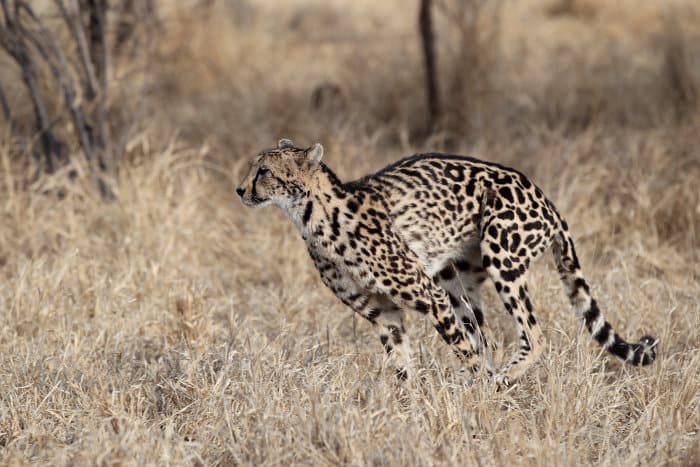
Are king cheetahs faster than regular cheetahs? A king cheetah’s top speed is the same as other African cheetahs’ speed: 120 km/h.
It’s another demonstration that the king cheetah is exactly the same species as the African cheetah, just with a different outwards appearance.
King Cheetah Facts 11-25
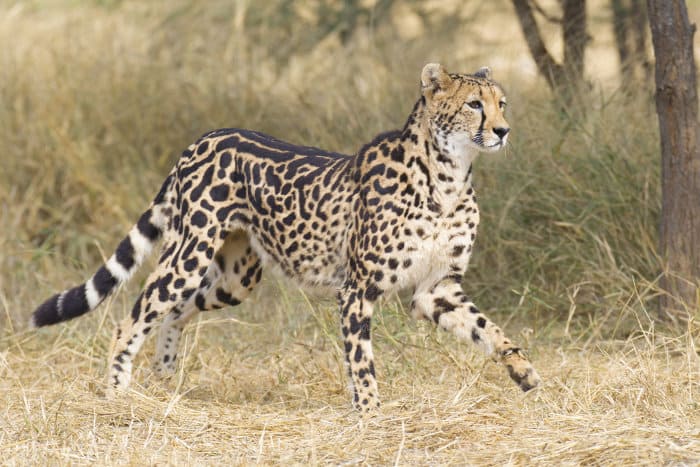
11. How many king cheetahs are left in the world?
The exact number of king cheetahs that exist in the world is unknown.
However, the estimated number of king cheetahs in the wild is less than 10.
The total number, including those in captivity and wildlife reserves, is around 60 animals.
12. Where do king cheetahs live?
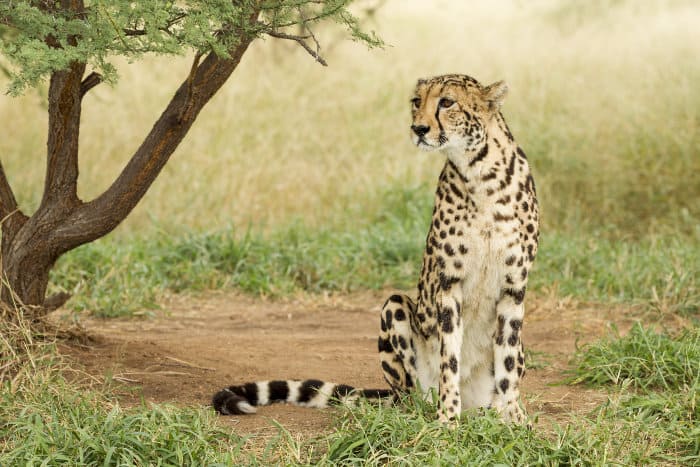
The king cheetah’s habitat is just like that of the African cheetah’s. These majestic creatures occupy grassy plains and flatlands such as savannas and deserts.
Open habitats are the perfect environment for a cheetah to hunt. Unlike other big cats, such as leopards and lions, king cheetahs don’t stalk their prey. They chase them rather, utilizing their rapid speed.
13. King cheetah size
The king cheetah doesn’t differ in size from the African cheetah. They have sleek and slender bodies built for reaching high speeds. From snout to tail they measure from 1.2 to 1.5 meters and weigh an average of around 50 kg.
Males are bigger than females and cubs reach a full-grown size at around two years old.
14. The rare king cheetah has a body built for speed
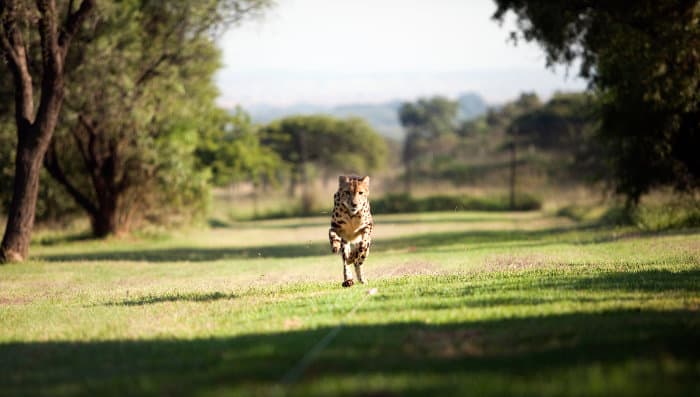
As the fastest land animal on earth, cheetahs have physiological features that enable them to reach such a rapid pace.
The king cheetah’s body is long and thin with a slender waist and powerful legs. This body shape is aerodynamic, allowing the animal to sprint at top speeds.
However, one of the most important factors contributing to their incredible ability is their organs. Cheetahs have enlarged hearts and lungs.
Coupled with the cheetah’s large nostrils, they are able to take in a lot of oxygen and circulate it effectively. The high amounts of oxygen are necessary to give their muscles the energy and power to run fast.
They may be fast, bursting to amazing speeds, yet they cannot endure these speeds for an extended time. The cats need to rest immediately after a hunt as it puts huge stress on their bodies.
15. King cheetah cubs don’t stand much of a chance
Cheetah cubs have notoriously high mortality rates, which is another contributing factor to an overall decline of the population. Only around 5% of cheetah cubs survive to adulthood.
One of the leading causes of this is death by other predators. Cheetahs, king cheetahs included, are mostly solitary animals.
So, the females have no choice but to leave their cubs alone and unprotected when they go hunting.
Lions, hyenas, jackals, and birds of prey often make a meal out of unattended cheetah cubs.
Even if the mother is around to protect her cubs, it is unlikely that she will be able to ward off a hungry lion or hyena.
The other leading cause of high infant mortality rate is a weakened immune system. Many cubs suffer from weak, undeveloped immune systems due to a lack of genetic diversity.
The declining population leads to a loss of genetic diversity, which in turn leads to cubs that are susceptible to disease and sickness.
16. A coalition of kings
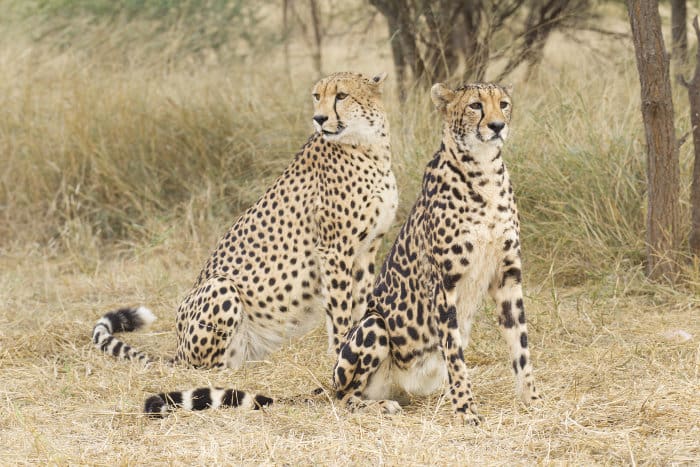
King cheetahs are aloof animals and don’t depend on social networks to survive. Female cheetahs especially, are solitary. They raise their cubs, hunt and live alone.
However, male cheetahs often tend to live in small groups, usually with other male siblings. The collective noun for this grouping is a ‘coalition.’
It’s highly unlikely that you’ll ever see a group of male king cheetahs in the wild. However, in the case that you do, you’ll be witnessing a coalition of kings.
17. The biggest threats that king cheetahs face
The entire cheetah population, including king cheetahs, faces threats due to human-animal conflict.
Overhunting, habitat loss, the exotic pet trade, and the illegal trafficking of cheetah body parts contribute to the rapidly declining population of cheetahs.
The Convention on International Trade in Endangered Species (CITES) lists cheetahs as an endangered species. The cheetah population is barreling towards extinction with an estimated 7100 of these big cats existing in the wild.
As the future of cheetahs is so uncertain, the future of the king cheetah is even more so. With dwindling populations of African cheetahs the likelihood of the rare recessive gene showing up decreases by the day.
18. They were once believed to be a cross between hyenas and leopards
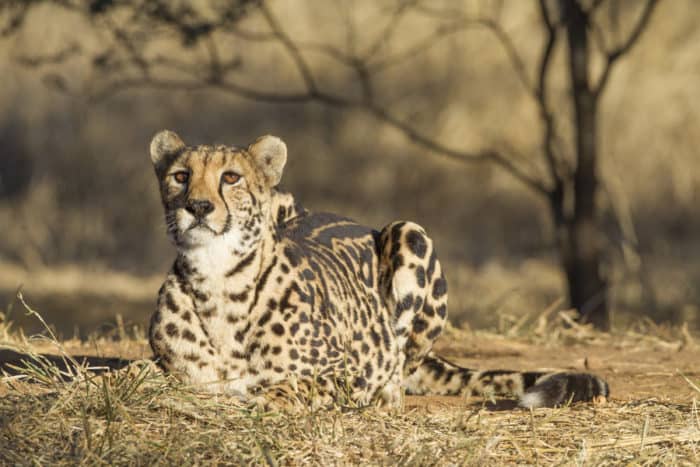
The legend of the king cheetah in African folklore dates back to a love affair between a hyena and a leopard.
Locals in Rhodesia, modern-day Zimbabwe, believed that the king cheetah was the offspring of this tryst and they called the rare animal nsui-fsi.
When settlers arrived in the country, they thought this story to be utter nonsense. So, Major A. Cooper came up with a better explanation.
After shooting the animal he sent an image to The Field magazine with the suggestion that rather than a hyena, a leopard reproduced with a cheetah.
19. Acinonyx rex is a redundant name
As mentioned earlier, the zoologist R.I. Pocock dubbed the unusual species Acinonyx rex after examining it at the British Museum. ‘Rex’ translates into English as ‘king’ or ‘ruler.’
Pocock used this name to distinguish the king cheetah as a separate species and the title lasted for over a decade.
In 1939, the lack of evidence proving the distinction between cheetahs and king cheetahs led to the acceptance that both specimens are one and the same.
Therefore, Acinonyx rex is simply a relic of the past. The king cheetah’s scientific name is also Acinonyx jubatus.
20. The first picture taken in 1975 in Kruger National Park

For decades after its initial discovery in Zimbabwe, the king cheetah remained a character of myths and legends.
However, in 1974 the first picture of a king cheetah put those tales to rest. Finally, there was solid proof that this magical creature roamed the African plains.
For many years following the initial sighting and photograph, there were no more sightings in the Kruger. More than a decade later, in 1986, another photo appeared proving the existence of two young king cheetahs in the southern region of the park.
This is the last recorded sighting in the Kruger National Park, and indeed, the world.
21. HESC welcomed the birth of two king cheetah cubs in 2013
The Hoedspruit Endangered Species Centre (HESC) witnessed something spectacular — the birth of two king cheetah cubs.
The most fascinating aspect of the arrival of these two unique balls of fluff is that only their father, Tristan, is a king cheetah.
The cubs’ mother, Tilla, is not a king cheetah, yet she carries the recessive gene.
22. Zoe and Zian born in 2015 at HESC
HESC had the honor of welcoming yet another two king cheetah cubs in 2015. You may be thinking that this is a brother-sister duo due to the naming. And the staff at HESC made that same mistake initially.
A couple of months after the birth of the cubs, the siblings were playing together and climbing trees. Unfortunately, a branch smacked Zoe in the eye, and the injury required veterinary attention.
It was then that the vet informed HESC members that Zoe was in fact a boy!
It’s difficult to identify the sex of cheetahs. While males are often slightly bigger, these cats don’t display the same degree of gender distinction as other big cats do.
23. Cheetah vs king cheetah: a possible 21st century sighting and debate
Kruger National Park’s Facebook sighting page and animal forums were alight with debate after a safari-goer posted a blurry picture of what looked like a king cheetah.
In February 2021, the photo caused a stir online as many felt that the poster doctored the photo to make the spots appear blotchy.
KNP has since removed the post from their Facebook page due to the heated debates.
24. King cheetah facts: diet

King cheetahs are carnivores and their choice of food is the same as the African cheetah. They hunt and consume medium-sized prey, and don’t have a regular feeding schedule as mealtimes revolve around hunting success.
Up to 58 percent of a cheetah’s hunts are successful. This is much higher than the success rate of leopards, and even lions.
Cheetahs hunt gazelles, such as Thomson’s gazelles, but also springbok, wildebeest, smaller antelopes, hares and rodents.
While the king cheetah has speed on its side, prey animals are often able to run for longer. This is their greatest advantage in escaping a cheetah’s claws.
25. It’s difficult to breed king cheetahs in captivity
There is a scramble to preserve the recessive gene that produces the enchanting king cheetah’s appearance. This is no easy feat, as the genetic pool of cheetahs becomes smaller by the day, while breeding in captivity is a struggle.
There are many challenges with breeding cheetahs in captivity. The cats won’t breed in front of humans and they require a lot of space to prosper.
The big cats experience chronic stress and have a much lower reproduction rate than other captive cats.
Additionally, captive cheetahs are susceptible to a number of diseases, so breeding for conservation is a constant uphill battle.
An Uncertain Future for the King of Cheetahs
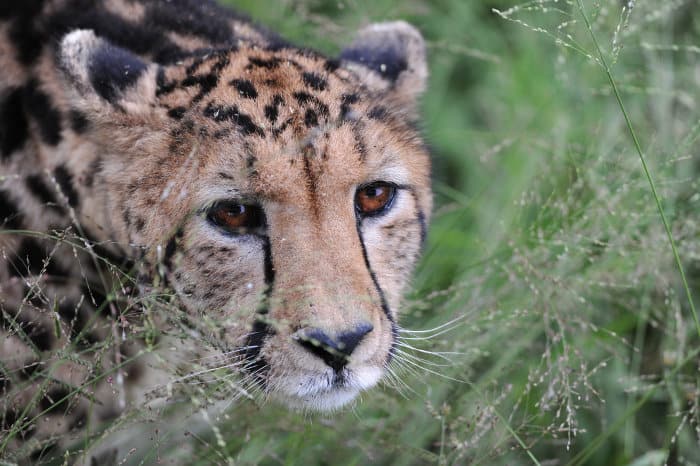
Originating from a place of myths, legends and supposed love affairs between unlikely animals, the king cheetah’s story is a fascinating one.
Mystery and unknowns shroud the animal’s existence. Yet one thing is certain, they are incredibly rare and their numbers are few.
Will you be next to snap a photo of a wild king cheetah?
While the chances of spotting these mystical cats are extremely slim, all you can do is try. Book a safari, keep your eyes peeled, and your camera ready — you may be lucky.



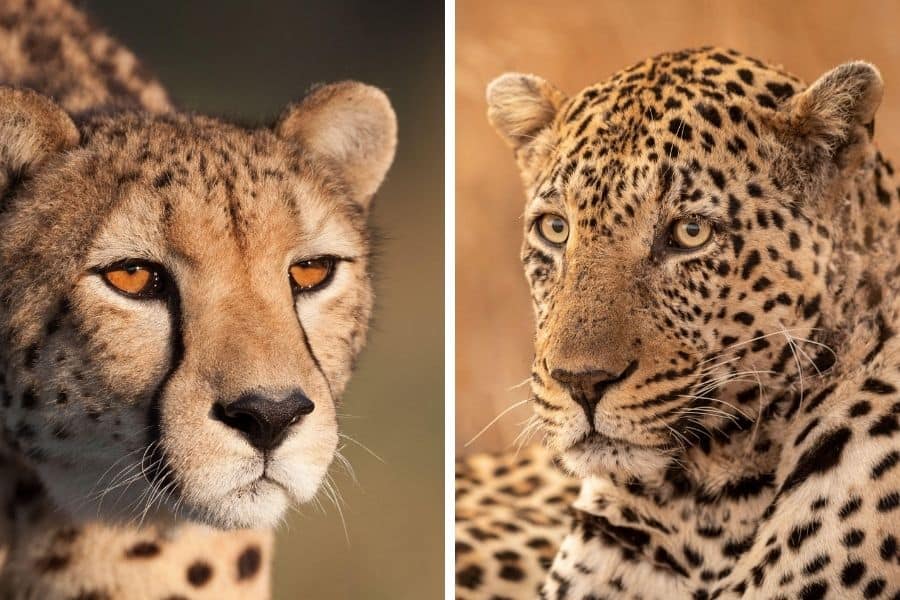
As all cats are beautiful, the king cheetah is one of my favorites. I am so glad people are trying to save this beautiful coat pattern. You never hear of them anywhere, I wish more was written about and I hope they find their way onto tv nature shows. I actually drew a picture of one as it was so beautiful and unusual.
I’m a little confused by the genetics. Why would a king cheetah only be born to another king cheetah?
If the trait is recessive, couldn’t a king cheetah be born to 2 cheetah who carry the recessive gene?
Hi Meagan,
I totally agree, it can be confusing! 🙂
Is the following statement where you got your question from?
If you look at the context (fact 5), the first paragraph states that “it is very hard for king cheetahs to reproduce more of their own.”
Indeed, two “normal cheetah” parents with the recessive gene can produce a king cheetah (there’s approximately a 25% chance for this to happen when they both carry the gene). But in order for those genes to then be passed on, you can only get a king cheetah for sure (100%) if both parents are also king cheetahs.
Hopefully this makes more sense… 😉
Take care,
Michaël
This information really helped me for my biology project, thanks a lot.
So happy it helped, Estefano. Good luck with your project! 🙂
I have seen them and I can send you pictures. I have been to De Wildt many times and have seen these beautiful creatures.
Hi Tom,
Are you referring to king cheetahs from the Cheetah Conservation & Research Centre (outside Pretoria)?
Sure, feel free to send your pics via our contact page. 🙂
Thanks,
Michael